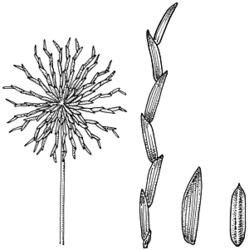Cyperus dietrichiae var. brevibracteatus (Domin) Kük. APNI* 
Description: Tufted perennial with very short rhizome.
Culms trigonous, smooth, 20–45 cm high, 1.5–2 mm diam.
Leaves not septate-nodulose, shorter than culms, to 2.5 mm wide. Inflorescence simple or subcompound, with 4–10 branches to 10 cm long, sometimes reduced to a dense sessile spike; spikes broad-cylindrical, to c. 1 cm long, c. 3 cm diam.; involucral bracts leaf-like, 1–3 longer than inflorescence. Spikelets terete, numerous per spike, flexuous, 10–20 mm long, c. 0.5 mm diam., almost subulate, 3–6-flowered; rachilla broadly winged; spikelet falling as unit. Glumes remote, closely appressed to rachilla, with sides several-nerved, 2.3–2.7 mm long, pale to red-brown. Stamens 3. Style 3-fid.
Nut trigonous, narrow-ellipsoid, more than half as long as glume, c. 1.7 mm long, c. 0.4 mm diam., dark grey.
Flowering: spring–summer.
Distribution and occurrence: Grows in woodland on sandy soil; north from Brunswick Heads.
NSW subdivisions: NC
Other Australian states: Qld
This differs from typical C. dietrichiae (in Qld and N.G.) in its shorter glumes and spikelets, fewer bracts, and generally more slender plants. It may be better treated as a species.
Text by KL Wilson (1993)
Taxon concept: Flora of NSW vol 4 (1993)
| The single variety in NSW. Characters and distribution as for the species in NSW. |
APNI* Provides a link to the Australian Plant Name Index (hosted by the Australian National Botanic Gardens) for comprehensive bibliographic data
***The AVH map option provides a detailed interactive Australia wide distribution map drawn from collections held by all major Australian herbaria participating in the Australian Virtual Herbarium project.
|


